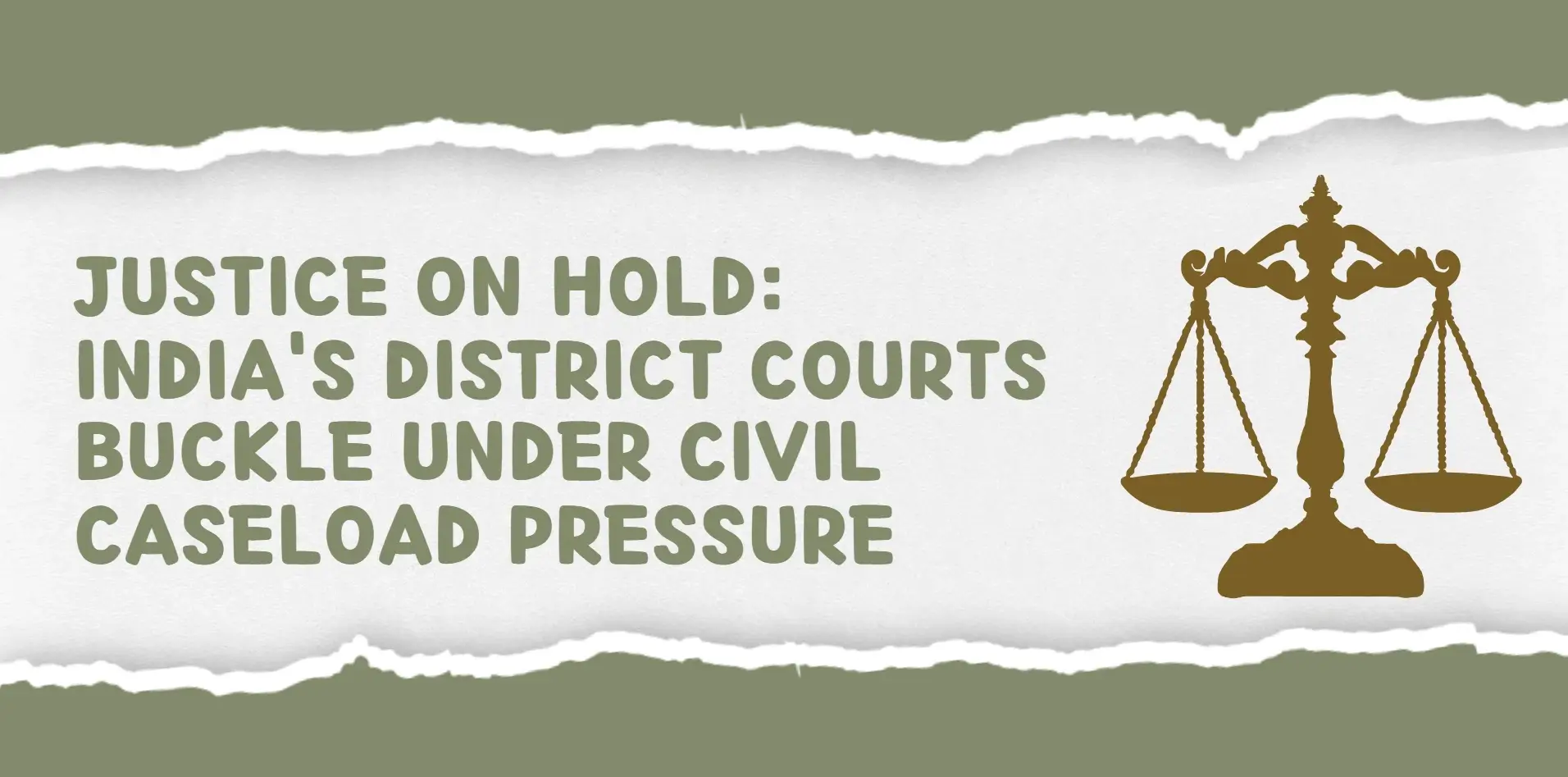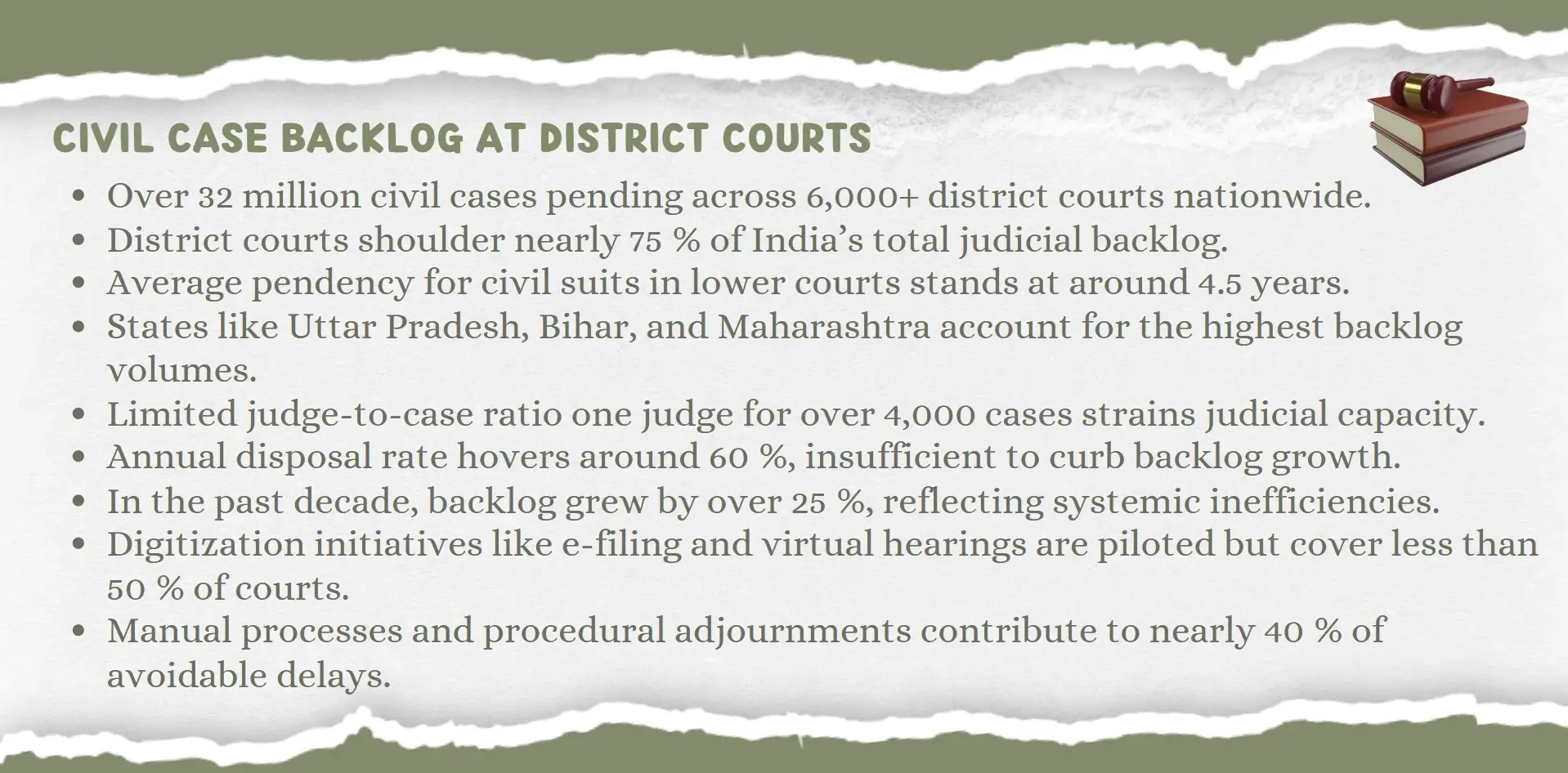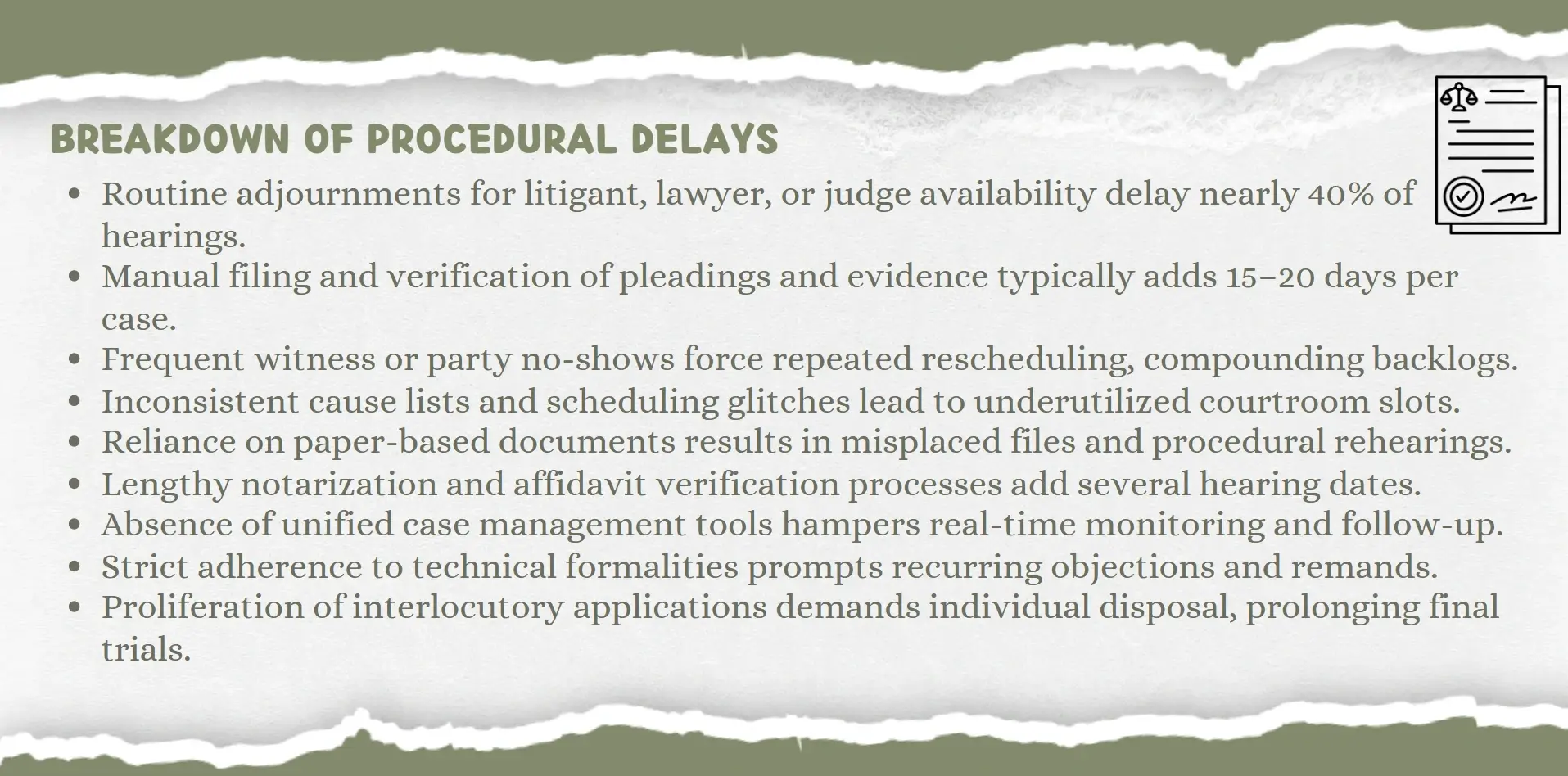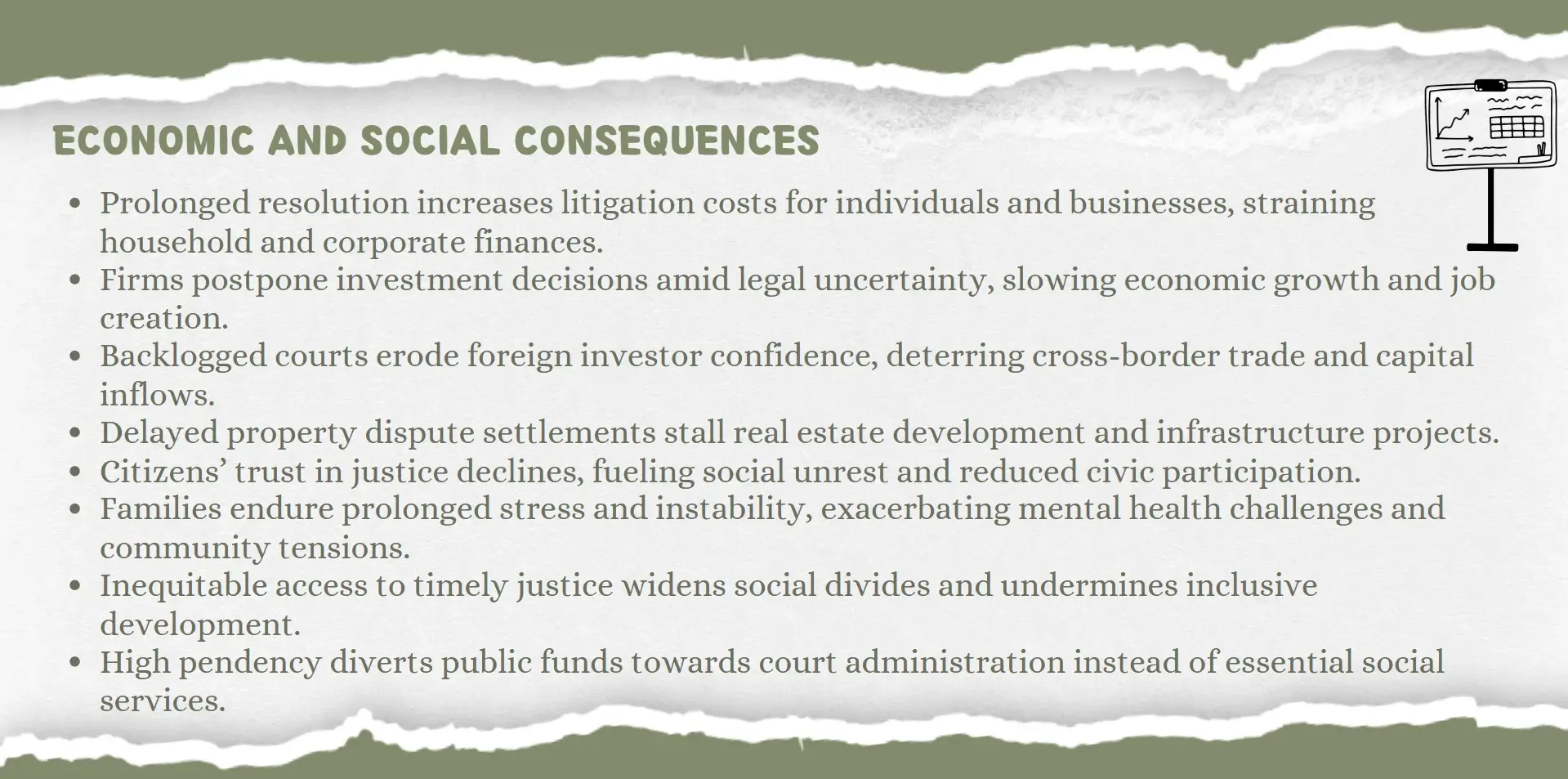Poor infrastructure, understaffing, and overburdening of district courts in India with procedures constitute a significant factor threatening to affect delivery of justice, as well as the level of trust placed by its users.

The district courts of India are the basic level of the justice system in the country. Their mandate is to settle the majority of civil disputes in the country. However, they are weighed down by sluggish incompetence that puts the population's faith in the rule of law at risk. This article discusses how procedural orthodoxy, a shortage of personnel in the system, and outdated infrastructural facilities have led to ordinary civil cases taking years to be solved by citizens in court. The district courts end up in a situation far beyond their means since they handle well over 40 million cases awaiting their attention, varying between property rights, family arguments, as well as contract enforcement. Backlog not only worsens the livelihood of litigants but also compromises the economic efficiency and democracy of India.The nature of the crisis is systematic and deeply rooted, with institutional doldrums and minimal policy creativity to deal with it. The interpretation and application of the law by the judiciary is critical to the governance process, but even the institution that provides judicial justice constantly lacks finances and facilities. Attempted reforms such as digitization, alternative dispute resolution, and allocation of resources more effectively have had potential but lacked consistent implementation across the board. Resolving the problem of litigation delay in civil cases is not a matter of procedure, but of democratic necessity with profound social and economic consequences.
The extent of the Crisis
Civil courts in India at the district level are in a state of acute stress. All these delays and inefficiencies are observed on a large scale, which is indicative of structural flaws and not symptoms of singular events. A legal bottleneck is apparent in the entire country.

A Strain on the System
With the current statistics, there are more than 40 million pending cases in various Indian courts, and 75 percent of the workload occurs at the district court level. The civil litigation, especially, tends to take an unnecessarily long duration, stretching to decades. These are land-related struggles, tenancy, inheritance and contracts, and those are the major issues in people life in day to day life. This kind of case accumulation is an indication of grave systemic exhaustion, whose effects reverberate throughout economic dealings, personal affairs, as well as government.
Resource Deficits and Structural Inertia
The numbers in the crisis are not the only issue; chronic understaffing, a lack of judicial infrastructure, and outdated procedures complicate the situation. Most of the courts lack proper online systems, adequate courtrooms, and skilled staff. Judges are used to dealing with hundreds of cases over a day and do minimal research or have any clerical support. Lack of case management systems and backlog monitoringtools also contributes to delays that create a culture of adjournments and loopholes in the processes,growing rapidly.
Economic and Social Consequences
Such unproductivity of civil adjudication discourages investment, makes it very difficult to sell property, and adds to the cost of the sale. To the citizens, the delay of justice means denial of justice,hence, a lack of confidence in institutions. The problematic effects of business disputes on both entrepreneurs and farmers occur when a land or contract dispute takes an extended period of time to resolve. The effect it has is a chilling of not just the personal rights but also of the more extensive developmental aspirations, in the ability to gain entry to housing, to the competitiveness of a business.
Need of Reform
What is required of the crisis goes beyond ad hoc interventions. There needs to be systemic reconstruction which involves digitizing, streamlining procedures and building capacity of judges. District courts are required to transform into procedural anachronisms to become receptive engines of justice delivery.
Operational and structural Causes
To this end, the backlog in the civil justice system of the district courts in India is deeply entrenched in structural weaknesses and inefficiencies that attest to the fact that the system has failed at ensuring timely resolutions of cases and the enhancement of institutional capacity.
Poor Court Facilities
Lots of the district courts are housed in shabby buildings, which are deprived of such basic conditions as sufficient courtrooms, libraries, and IT infrastructure. Facilities that are too many leave the judges to share courtrooms, and problems of storage result into mishandling of the case files and evidence. It adds to the fact that there is no computerized record-keeping mechanism, which is why adjournments and procedural chaos are common.
Lack of Judicial Personnel
The authorized judge strength sometimes proves to be less than what is required and vacancy rate in certain districts rises to over 30% mark. They can be given hundreds of cases to hear by a single judge, and the hearings have to be shallow and the adjournment periods have to be brief. Very important support personnel such as clerks, stenographers, bailiffs, are also underutilized and this is a hindrance in the running of the court. This shortage of staffs compromises the quality of justice and significantly retards the rate of dispensation of cases.
Excessive Formalism
The codes in force during the colonial times are still in use today in civil litigation and pay a lot of attention to formal elements. Strict procedural regularity and liberal adjournments also unnecessarily postpone the trials. There are no established systems of case management, so the judges track the progress manually, which is an administrative overload. The delay is further complicated as litigants and attorneys tend to take up the game of procedure holes toprolong litigation to gain some strategic benefit.
Lack of Performance
District courts do not have any transparent monitoringrate where time of a case is tracked, productivity of these judges can be tracked and disposal trends recorded. In the absence of performance based analysis or backlog measures, delay is the new normal. This institutional structure of the judiciary isolates the body that has little administrative flexibility and policy feedback in real time to compensate the restraint in the institution that is based on the idea of self-correction of the operational bottlenecks.
Effects of judicial delay
Such delays in civil litigation are detrimental to both the personal liberties and collective governance of the overall process as well as economic activity and public trust- ripples spreading widely through the society and the development in general.

Public Trust and Democratic Values
With the delay of justice being dispensed by courts, citizens cannot believe that the system will give justice, and they lose faith in the democratic system. Slow justice diminishes the value of equality before the law, especially in the situation of the marginalized group of the population that may not be capable of fighting lengthy court battles. With time, these delays create a sense of impunity, undermine the civic use of legal standards and discourage the exercising of institutional remedies.
Transaction Insecurity Drag and Economic Drag
Constant lawsuits diminish the efficiency of the economy. The contract and property disputes that are not resolved lead to the freezing of capital, hampering investments and increasing the costs of transactions. Infrastructure projects are delayed by land acquisition and tenancy strife and there is the fear of unpredictability of legal decisions, which pushes investors and entrepreneurs away. The systemic lag of the law courts becomes an embodiment of the systematic bottleneck of development, provoking the macro-policy level and the micro-financial security.
Personal Suffering and Social Disfigurement
Lengthy litigation becomes economically, socially, and emotionally draining to families and the people involved. Cases of inheritance disputes can tear apart families potentially all the way into generations; unaddressed tenancy challenges can drive people to the streets or slums. Civil litigation can be a decade’s long process that unbalances life in an unquantifiable way; this element leads to anxiety, disillusionment, and even extra-legal retribution.
Increase of Extra-Legal forms and Informal Justice
In cases where courts are unavailable or unless they are being unproductive, communities use informal dispute resolution autonomously in some instances relating to caste panchayats or local power brokers. Some of the alternatives are fast, whereas the others undermine fairness and legality. The phenomenon of judicial sovereignty undermined by normalization of non-state adjudication results in the development of parallel systems with development of unequal accountability.
Comparative Insights
The delays in the civil courts in India are not isolated phenomena, and indeed in other jurisdictions, the asymmetry between system-wide design features and individual processes may have similar causes as in India, but scalable innovative solutions in other jurisdictions demonstrate ways in which India can emulate them to alleviate its crisis of litigation involving the district courts.
UK
The structured case management system has enabled civil courts to simplify their proceedings in the United Kingdom. Electronic filing and preliminaries limit ambiguity and repetition in procedures. The judges have the authority to manage schedules and reduce adjournments and stallings. The Civil Procedure Rules are neither too strict nor too loose, as is the case in India, as they allow some degree of flexibility but accountability. Periodic performance audits are useful in self-correction and the optimum utilization of resources by the courts.
US
The United States is based on decentralization and small dispute claims, which are fast and have short simplifications. Also, courts promote the approaches to Alternative Dispute Resolution known as mediation and arbitration as the initial practice before actual trials. This two-path solution is beneficial in that It does not overwhelm district courts and hands out faster judgments. In India,the ADR efforts in India have increased, but are not standardized or disseminated.
Netherlands
Dutch civil justice is citizen-centredlegal design, which includes digital channels, plain language, and structured channels to be followed by litigants. The online dispute resolution systems will help citizens to privately solve disputes without entering the courtroom; this will free up judicial bandwidth to handle complicated disputes. The incomplete and infrastructure-limited nature of India is to be filled with digitization, and therefore, this model is idealized but is also educational.
Singapore
The judiciary in Singapore is a prime example of proactive leadership in the realms of technology integration, including but not limited to AI-aided court calls, as well as the digital processing of evidence. It also ensures judicial accountability by way of transparency in benchmarking. The judicial framework in India is more federal and large in size, but the focus on innovative leadership and clean operations may initiate the reform process, especially in the metro district courts.
Trajectories to Reform and Policy Proposals
Focusing on judicial delay in district courts where civil cases are heard, reform must be complex and in levels, both short-term and long-term, so that the institutions can be resilient and enjoy citizen confidence.

Simplification of Procedure and Case-handling
India must switch to dynamic case management solutions from rigid case management codes. Case flow can be minimized by means of introducing litigation protocols that operate on timeline, the introduction of mandatory pre-trial scheduling and introducing the digital cause lists. The judges must be enabled to restrain the excessive adjournments and inculcate the hearings subject to milestones. Fine tuning of the Civil Procedure Code (CPC) would also be an added advantage especially in the removal of obsolete technicalities.
Development and Training of the Human Resource
It is essential to address judicial vacancies. Accelerated placements of lawyers, open recruitment pipelines and incentives to serve the judicial districts with less judicial representation should be encouraged. In addition to the figures, the training in digital tools, mediation strategies, and trauma-informed adjudication can enhance the effectiveness of the work of judges and their level of empathy. The capacity of the support staff needs to be expanded and professionalized too to facilitate efficient activities of courts.
Digitization and Upgrade of Infrastructure
Logistic bottlenecks can be mitigated by robust investment in digital infrastructure e-filing systems,video conferencing, online evidence portal, etc. District jobs require safe cloud-base databases and AI-aided docketing to coordinate cleverly and note delays in proceedings. At the same time, the lack of infrastructure can be filled in with such physical improvements as special civil courtrooms, accessible environment, and litigation electronic kiosks.
Policy Feedback and Institutional Accountability
Courts should implement some performance metrics equipped to monitor the case disposition rates, the average rate of hearings, and the procedures timeline confirmation rates. Transparency and policy feedback may be provided by judicial dashboards and annual district court audits. The formation of justice committees at district levels involving judges, lawyers, and civil society can assist in such problem-solving and help make changes to be adaptive.
Conclusion
In India, judicial delay has actually come to represent a governing failure, in the country district level civil courts, under an existential pressure now. The pasteffects of old systems of doing things, poor infrastructure, and manpower have cooked up a system of delivering justice, which on many occasions has failed to empower the population rather than enslaved them. As has been shown in this article, the reform needs to be multidimensional,providing both the aspect of procedural change, expansion of human resources, adoption of digital technologies, and systems of accountability and cross-national learning.Civil justice must be done quickly in order to be a fundamental part of democratic legitimacy and socio-economic development. Access to property, livelihood, dignity, and public trust, among other things,is characterized by legal redressformillions of citizens. It is not just fixing the system in terms of eliminating a backlog; it is to drive institutional trust and unleash justice as an everyday entitlement. The future of India depends on a responsive, inclusive, and diverse judicial system, which is structurally accommodating to those it was designed to serve.